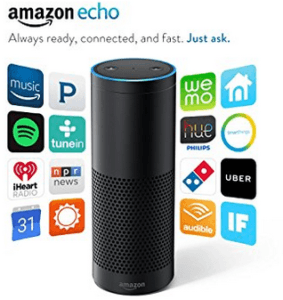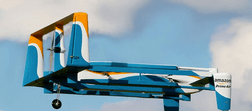If You’re Not First, You’re Last: Amazon’s Never-ending Innovation

Amazon is not afraid to make moon shot investments. What's next?
How can a company maintain incredibly high investor interest, despite taking nearly ten years to record its first annual net profit [1]? By building a company around eschewing short-term gains for long-term success, Amazon has been able to invest in technologies for the future. Digitization has helped optimize Amazon’s warehouse and distribution system (and created products like Amazon Web Services), and more recently brought to life two integral customer touch points.
Hi Alexa
Alexa is Amazon’s AI persona that is used on the Echo and Echo Dot devices to connect the company to your household. Amazon’s mission statement is as follows:
“Earth’s most customer centric company; to build a place where people can come to find and discover anything they might want to buy online.” [2]
Their business model relies on creating the easiest way for customers to obtain products at the best price. This new AI product allows users to seamlessly order products without typing a word or clicking a button. More conveniently, it can answer many questions and integrate into your home systems to turn on your stereo or nearly any other device with which it can connect, creating a smart infrastructure [3] and generating incredibly valuable customer data [4]. Amazon is digitizing the order process as spoken words are received and then converted into commands by these incredible machines, allowing the company to more effectively execute on their customer promise.
Flying into Your Home
Delivery is the opposite end of the consumer touch model. In the past several years, Amazon has invested heavily in a drone delivery system. This is viewed by some as a moon shot, but Amazon has begun proving out its technology, with tests taking place in the UK [5]. The advanced sensors on drones allow them to navigate effectively through even the most crowded airspaces by taking in massive amounts of data and converting it into directional flight inputs [6]. On a larger scale, this technology will allow Amazon to execute on its promises by autonomously delivering products exactly when and where you want them. This will improve the company’s operating model by fulfilling customer desires even more quickly.
Threats & Failures
Amazon’s propensity for massive investments has led to high profile failures such as the Fire phone, which forced Amazon to take a $170 million charge on the lost value of unsold phones [7]. In addition to reputational risk if one of these new products failed, the company is entering crowded markets. Apple’s Siri dominates iPhones, and there are plenty of other mobile assistant apps on the market.
The drone market is also crowded with companies ranging from Alphabet to start-ups. However, even if companies develop similar drone technology, when paired with Amazon’s existing service there is no company that can currently replicate the entire delivery model they envision when paired with their fulfillment centers.
Recommendations
Continued large investment in Alexa – Alexa has been noted by some as klunky and lacking the top voice recognition skills that a refined assistant like Siri does. In order to be adopted by the masses, the recognition and interface with Alexa will need to be seamless.
Introductions to Alexa – The two main price points for Alexa are the Echo at $179.99, and the dot at $49.99. There is an app, but reviews are putrid. Customers need a way to test drive Alexa before buying. This may be vastly improving the app, or more actively integrating Alexa into the Amazon app. This would allow customers to be introduced without downloading anything new, making the transition much easier.

Increased partnerships – Alexa can order you a Domino’s pizza with just one command [8]. An increase in the number of this type of large corporate partners will draw media attention in addition to increasing functionality.
Tightly partner with the FAA – Amazon has been testing its drones in the UK because their airspace regulation incorporated drones in 2010. Amazon is clearly making efforts to influence future drone regulations created by the FAA [9], but this is so integral to their future that massive investments must be made here because it is make or break.
Drone Safety – One of the biggest issues for individual consumers with drone delivery is safety. Where will the drone land? Can it deal with moving people and objects? Large scale public displays of the drone’s ability to avoid danger for itself, and more importantly the consumer, will help to assuage any of these concerns. Holding these displays in large cities could be a great launch event to garner attention and create a sport-like spectacle of the maneuverability and usefulness of these unpiloted machines.
Amazon has proven they are the masters of optimizing and automating internal logistics. Now they are making huge investments from the customer’s first interaction through to the last mile of delivery that will pay off handsomely.
(798 words)
Sources
[1] Wingfield, Nick. “Amazon Reports Annual Net Profit For the First Time.” The Wall Street Journal. N.p., 28 Jan. 2004. Web. 16 Nov. 2016.
[2] Hull, Patrick. “Be Visionary. Think Big.” Forbes. N.p., 19 Dec. 2012. Web. 15 Nov. 2016.
[3] “Amazon Echo.” Amazon. N.p., n.d. Web. 16 Nov. 2016.
[4] Leber, Jessica. “Amazon Woos Advertisers with What It Knows about Consumers.” MIT Technology Review. N.p., 21 Jan. 2013. Web. 15 Nov. 2016.
[5] Scott, Mark. “A Peek at the Secret English Farm Where Amazon Tests Its Drones.” The New York Times. N.p., 01 Oct. 2016. Web. 17 Nov. 2016.
[6] “Amazon Prime Air.” Amazon. N.p., n.d. Web. 15 Nov. 2016.
[7] Rubin, Ben Fox, and Roger Cheng. “Fire Phone One Year Later: Why Amazon’s Smartphone Flamed out.” CNET. N.p., 24 July 2015. Web. 15 Nov. 2016.
[8] Pullen, John Patrick. “10 Apps That Make the Amazon Echo Even Better.” Time. N.p., 16 Mar. 2016. Web. 15 Nov. 2016.
[9] Kang, Cecilia. “FAA Issues Commercial Drone Rules.” The New York Times. N.p., 21 June 2016. Web. 17 Nov. 2016.
Pictures (in order of appearance)
“Amazon” Amazon. N.p., n.d. Web. 16 Nov. 2016.
“Amazon Echo.” Amazon. N.p., n.d. Web. 16 Nov. 2016.
“Amazon Prime Air.” Amazon. N.p., n.d. Web. 15 Nov. 2016.
Apple App Store. 16 Nov. 2016.





CK – Very engaging post. Thank you.
I agree that safety and actual delivery will be two critical challenges that Amazon has to figure out. I would add that drone deliveries in populated areas with apartment dwellers can be extremely challenging, especially when there is no appropriate space for a drone to land such as a front or back yard. Hence, one solution that Amazon sees at this point in time for this type of areas is to grow their network of package pickup way-stations where customers will go and pick up their goods. I would argue that it is important for the company to continue to invest in this infrastructure going forward as it will facilitate deliveries in populated areas. Please see below relevant article.
http://mashable.com/2015/11/30/amazon-prime-air-reality/#_SINOqRmskqn
Drone delivery is a fascinating innovation and I’m sure that it will save amazon a lot of money if they can actually get it implemented in the U.S. I would be interested to know how this new delivery method would effect Amazon’s current delivery model. There would probably be some limit to the size and weight of packages that drones would be able to deliver. Assuming this is the case, Amazon would probably need to maintain some level of traditional distribution. Would the reduction of volume flowing through the traditional distribution methods adversely effect the delivery time for some items? I would be interested to know if Amazon ever considered acquiring any of the smaller companies working on drone technology instead of creating and internal team to focus on this technology. How did this decision effect their speed to market and operating model?
My inner geek wants to believe drone delivery will be huge, and many others seem to agree given the number of drone startups coming out of the most recent Silicon Valley accelerators. https://techcrunch.com/2016/08/23/yc-demo-day/
I have heard a few arguments against the inevitable drone revolution. While I agree drones are a hugely useful technology, I wonder if image we have of a sky filled with little flying amazon boxes is a bit misguided in the short term (much like the Jetson’s depiction of a sky filled with moving sidewalks and personal flying cars).
For example, let’s examine very urban cities. The building architecture creates many unpredictable wind tunnels that seem to make drone navigation especially challenging and greatly increase the costs of accounting for flying condition variability (and related accidents). Also, for taking delivery, we currently require a secure place to store the package, whether it’s at a local aggregation center or with your building doorman. Would it make more sense to rethink how we handle last-mile package distribution and storage, as these problems still exist when we airdrop them at the require address?
I think Amazon is in the correct path to maintain competitive advantage in the distribution field. I agree with you that are several concerns and opportunities regarding the use of drones, but Amazon must keep investing in this new technology before a competitor brings it to the market. I would look for the developments of UAV in military applications (1), and try to apply some lessons to their product development.
(1) https://www.uavs.org/military